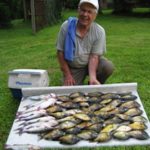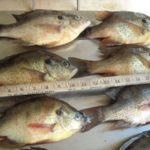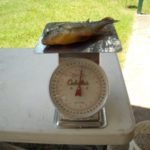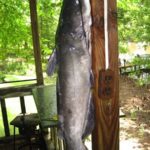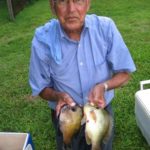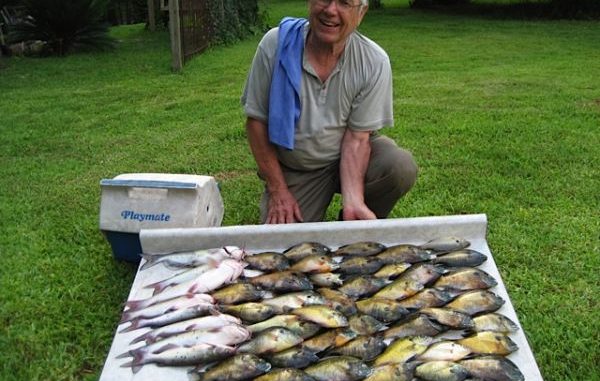
While shallow beds are what most anglers think about when they target bream, it might pay to back off the banks when fishing reservoirs. Here are some tips on catching deepwater bulls.
Is there anything better than the fast action of a spring bream bed? The big redears we call shellcrackers in South Louisiana and chinquapin up north go to the warming shallows first, followed by bluegill and other sunfish.
When that happens, it’s time to take advantage of the golden opportunity to battle big panfish on a fly rod or ultra-light spinning gear.
Filling the cooler with chunky “bull” bream can work up an appetite, remedied by a fish fry at sundown. It’s just one more reason to love spring in the South.
The only thing wrong with spring bream fishing is it doesn’t last forever. As the early spawn winds down, the hot summer sun drives the fish off the shallow beds. On Louisiana’s natural, mostly shallow lakes where deeper water can be hard to find, the bream move to the shade of cypress and tupelo trees for the summer spawn.
On man-made reservoirs like Toledo Bend and Central Louisiana’s Cotile and Kincaid lakes, shade trees are pretty scarce but deeper water provides the cool to moderate temperatures needed for continued bedding through hot summer.
And good concentrations of bedding panfish providing outstanding fishing all summer long can be found in those deeper waters, if you know where to look.
Marcus Robichaux of Boyce has it figured out.
He and fishing buddy Amos LaCaze take home cooler loads of big redears and bluegills through the summer using methods Robichaux has developed for man-made waters.
I have to toss in a mention here that Marcus is a life-long friend, and that LaCaze fellow, well, he’s my dad.
My wife (and fishing partner) Mitzi and I fish Kincaid, too, and we keep a friendly competition going with Dad and Marcus all summer.
Robichaux fishes primarily on Kincaid, with occasional side trips to Cotile and other Central Louisiana lakes. But his methods should work on any reservoir with similar depths and bottom characteristics.
Give the fish time to transition from shallow water spring bedding areas to deeper summer habitat, find the right combination of depth and bottom features, and catch fish into July and August.
He said a good friend, the late Cordie S. Lewis of Monk’s Corner, S.C., showed him how to fish such reservoir terrain.
“The first thing to remember is that man-made lakes put water where there was once dry land,” Robichaux said. “If that land had roads, ditches, old creek beds or changing terrain, chances are fish will be there.”
Kincaid Lake has all the above, as can be seen on old maps dating back before the mid-1970s when the reservoir was built and flooded. Open waters of the lake devoid of any trees, stumps or boat lanes conceal old roads, railroads, ditches and temporary dirt dams and levees.
Average water depths of 17 to 18 feet fall to 25 feet or more in ditches and creeks and jump to within 10 to 14 feet of the surface over roads, railways and ditch banks.
“Some of the creek beds were dug out or straightened and ditches were dug to improve drainage during construction,” Robichaux said. “And the dirt was piled alongside. So now you have places where the bottom suddenly jumps from 18 feet to 12, before falling into a 25-foot-deep ditch or creek bed.
“Find one of those 12-foot knolls of sand and gravel alongside a rapid drop to 20 to 25 feet, and you should find fish.”
Obviously, the only way to know whether fish are holding on your shallow spot is to catch some, and that requires a little special technique, as well.
Forget fly rods, flies and bobbers: These fish won’t be caught on the surface or in mid-depth waters.
This is bottom-fishing or tight-line fishing only with live bait. According to Robichaux, worms work best.
“Amos and I use red worms we raise ourselves,” he said. “The redears aren’t crazy about crickets, but both bluegill and redear love worms, so we just stick with those.
“You’ll get a nice catfish every now and then, too.”
Bait presentation can determine how many fish go in the cooler, and Robichaux has three basic methods.
“Anchor over a spot that looks good on the depth finder,” he said. “Let the bait fall to the bottom, and then slowly lift it a foot or so, then let if fall again. Repeat that every few seconds.
“If that doesn’t work, just slowly crawl the bait along the bottom. Or you may have to just let it lie still until a fish picks it up.
“Try all three, because some days one works much better than the others.”
Robichaux recommended good boat anchors to hold the boat firmly in place. Wind and wave action on open water can make that difficult to do.
Light, sensitive tackle works best. Ultra-light spinning rigs with 4- to 8-pound-test monofilament or jig poles are great choices for this work.
Kincaid is known for big redears, some weighing a pound or more, and they’ll put light tackle to the test. One or two 1/8-ounce split shot a foot or so above the hook will put the bait on the bottom.
Robichaux has a favorite hook: the H&H size 6 Blue Carlisle. A small landing net is recommended for getting big redears in the boat, and it’s a must for the catfish.
A good depth finder is essential, and pre-reservoir maps will reveal bottom structure worth exploring on man-made lakes.
Robichaux uses a GPS to mark his hotspots and the depth finder to pinpoint that perfect depth.
The right spots will hold fish year after year, but for reasons known only to the fish they might not be at the same location every day.
“We may try two or three spots before we locate fish,” Robichaux said. “But once we find them, it usually pays just to sit right there. They’ll bite in spurts, and we’ll put several in the boat in a few minutes.
“Then it may slow down for a while, as if they’ve moved off. But business will pick up again with a little patience.”
They’re not called sunfish for nothing, and the big bluegill and redear actually tend to bite better from mid-morning to noon. Late afternoon can be productive, as well. Bimini boat tops and umbrellas provide some shade and can extend fishing time in the intense heat of the sunny South.
